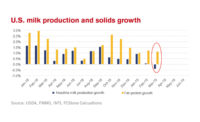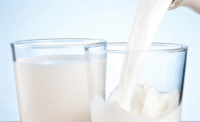

Suchismita Roy is pursuing her Ph.D. in Food Science at Kansas State University. She has a Master’s Degree in Dairy Technology from National Dairy Research Institute, India. She is an active member of the Dairy Foods Division of IFT and works with the Resource Library team.
Abrielle Schnurr is working on her Master’s Degree in Food Science at Kansas State University. She has been an active member in IFTSA since 2019 and was the chapter leader at NDSU in 2021-2022.
From the beginning of the agricultural process to the final consumer experience, a magnitude of innovations has led to reducing the environmental impact of the dairy business. Across the stages of production, transportation, and consumption, the industry has made significant strides toward a cleaner future and ensuring greater satisfaction of consumers.
At the farm, enhanced management of animal feed, improved genetic potential of animals, and deeper insights into lactation cycles, therefore, have collectively resulted in an increased milk yield by 19% and reduced greenhouse gas emissions by 17%, and land and water usage by 26% and 10% (1). Ongoing research is directed toward the production of forage crops with higher fiber digestibility and protein utilization by the animals, and the production of new crops that have higher climate resilience such as sorghum (2). In terms of on-farm innovation, the smart dairy farming model involves the utilization of machine learning algorithms, big data generated by sensors, and the Internet of Things (IoT) has not only improved milk yield but enhanced the efficiency of production and processing (3).
Improving farm yield
The strategic application of artificial insemination utilizing sexed semen has been proven to improve production yield, longevity of animals, and milk quality (4). Knowledge of the relationship between the genetic variability of cows and milk composition is enabling breeders to produce calves for product-specific traits (5).
Consumers are more conscious about food waste, environmental pollution, and the consumption of natural resources associated with dairy supply chain systems (6). Although there are huge improvements in cooling technologies and different modes of transportation systems, many hurdles still persist in the pursuit of implementing innovations in the traditional type of dairy supply chain (7).
Clean labels in demand
At the fork level, consumers have an increasing preference for clean labels and minimally processed dairy products, which is driving the range of innovations in the dairy processing sector (8). The modification of ingredients through various treatments such as filtration, high-pressure processing, cold plasma, and pulsed electric technology is utilized to reduce the use of ingredients undesirable to consumers such as stabilizers, emulsifiers, and sweeteners in product formulations (9). In the era of “Food as Medicine,” milk is one of the most valuable food matrices that is known to be rich in bioactive peptides, fat globule membranes, growth factors, glycomacropeptides, and immunoglobulins.
As a result, intensive research is taking place all over the world to extract these bioactive peptides at the commercial level and apply them in foods and pharmaceutical products. To deliver high-quality products with utmost safety, researchers are diligently developing sophisticated tools like biosensors which are fast, safe, convenient, and reliable.
Consumers are geared towards products with high nutritional values, cleaner labels, sustainable, and “better for you” products. To cater to health- and environment-conscious consumers, it is important for the dairy industry to drive innovation toward sustainable practices both for the environment and animal welfare right at the farm level. Innovations related to energy-saving practices in dairy plants, reducing wastage in processing, and developing products with functional benefits remain at the forefront. From manufacturing to the consumer, innovation is happening throughout the dairy industry, from farm to fork.
References
- Environmental Benefits of Modern Dairy Study Unveiled by AEM, Dairy Organizations at World Dairy Expo, Milwaukee, October 4, 2022. (https://presspage-production-content.s3.amazonaws.com/uploads/2544/2022environmentalbenefitsofmoderndairyhayandforageproductiontechnologiespvfinal1.pdf?10000). Retrieved on 15 July 2023.
- Martin, N. P., Russelle, M. P., Powell, J. M., Sniffen, C. J., Smith, S. I., Tricarico, J. M., & Grant, R. J. (2017). Invited review: Sustainable forage and grain crop production for the US dairy industry. Journal of Dairy Science, 100(12), 9479-9494.
- Nleya, S. M., & Ndlovu, S. (2021). Smart dairy farming overview: innovation, algorithms and challenges. Smart Agriculture Automation Using Advanced Technologies: Data Analytics and Machine Learning, Cloud Architecture, Automation and IoT, 35-59.
- Titorenko, K. V., & Zhichkin, K. A. (2021). Innovative approaches to breeding in the dairy industry. In IOP Conference Series: Earth and Environmental Science. 723 (3), p. 032003.
- Lusk, J. L., & McCluskey, J. (2018). Understanding the Impacts of Food Consumer Choice and Food Policy Outcomes. Applied Economic Perspectives and Policy, 40(1), 5-21.
- Glover, J. L., Champion, D., Daniels, K. J., & Dainty, A. J. (2014). An Institutional Theory perspective on sustainable practices across the dairy supply chain. International Journal of Production Economics, 152, 102-111.
- Cannas, V. G., Ciccullo, F., Pero, M., & Cigolini, R. (2020). Sustainable innovation in the dairy supply chain: enabling factors for intermodal transportation. International journal of production research, 58(24), 7314-7333.
- Saldo, J., & Sendra, E. (2022). Recent Advances and Trends in the Dairy Field. Foods, 11(13), 1956.
- Wansink, B., Tal, A., & Brumberg, A. (2014). Ingredient-based food fears and avoidance: Antecedents and antidotes. Food Quality and Preference, 38, 40–48.





